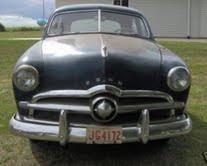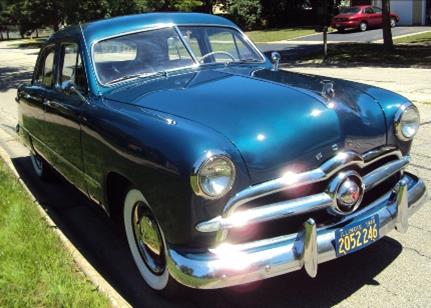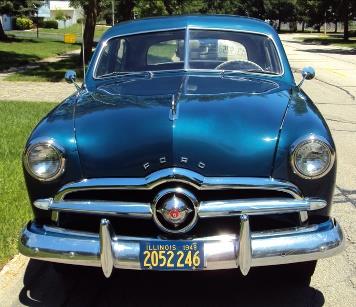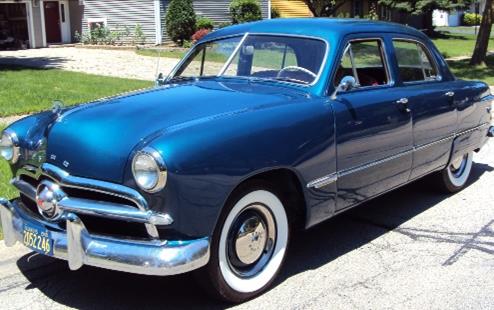1949 “Shoebox”
Ford Restoration Project
What I learned about the process
of bringing back a 1949 Ford
By John
Emmering
The idea of getting
another 1949 Ford like the car I owned as a teenager came to me while working as
a contractor for the U.S. Army Education Center in Kuwait back in 2005.
Removed from family and friends and with little to occupy me in my free
time I started to view pictures and information about everything I could find on
1949-51 Fords. After being introduced to
eBay, I suddenly had the possibility of buying one of those cars once again.
Having delved into some old issues of Auto Restorer Magazine, and through
experience I see that there might have been some more optimal procedures I could
have taken.

First, I bought my
1949 Ford sight unseen. This of course is not the best way to go.
Fortunately, my car, while rough in places had a good running engine and
solid floors. Even for its
shortcomings it was worth the purchase price. However, I really could have
walked into a disaster and there are many horror stories out there. It’s best to
check out the car personally or at least have a trusted fellow Ford V-8 club
member living nearby give an opinion.
Also important is the
body style. It’s always best to try
to find the most desirable body style to make the most of your restoration
investment. Had I known how much I
was going to spend in restoration work I think I would have sought out a more
desirable body style than a Fordor.
It has grown on me and was the same body style as my earlier ‘49er but it has
less resale value. In considering a
car to restore we are warned to try to find a vehicle needing as little bodywork
as possible as body repair can be quite costly.
Mechanical repair is often less costly than extensive body work.
When I went up to
McFarland, Wisconsin to view my 1949 Ford while on leave from Kuwait, I learned
that the seller bought it from a farmer from Winslow Illinois.
The 1966 Illinois plates it bore belied the fact that it had sat idle for
about 40 years. The man I bought it
from had planned to fix it up but lost interest. So, I had sort of a barn find
on my hands.
I arraigned for a
restoration shop to get the car operational during my next term in Kuwait. The
first thing I should have seen to was the gas tank.
A car sitting so long is bound to have rust and debris there.
Removing the tank and using a tank sealer kit would be a really good
early step. In my case I purchased a new gas tank after trying to drive the car
a while with a dirty gasoline tank which gave me plenty of trouble.
The new tank has the drawback of needing a replacement sending unit,
which in most cases are not accurate. Mine indicates “empty” when I am only two
thirds down, so I never run out of gas. Also, my car had really bad motor
mounts. It was a wonder the engine didn’t fall out. A good early step would be
installing a new set of quality motor mounts.
New water pumps might be installed at this point also. When I finally
returned to Illinois after working overseas the 1949 Ford sat once again in
storage for three years until work began in earnest in 2009.
Glaring problems were the rusted-out rocker panels and rusted through
places on the left front fender and left rear wheel well.
Also the left front door was in poor shape.
I was back on eBay where I located a pair of full rocker panels for a
1949 Fordor. Dennis Carpenter Ford Parts supplied patch panels for the lower
front left fender and rear wheel well.
The body work and paint would have been out of my price class had I tried
a professional shop but my brother’s friend Rich, a temporarily unemployed body
man, offered to do the body and paint work at a very affordable price.



While working
overseas I had been buying trim pieces from eBay for my 1949 Ford project and
having them sent home. I picked up
all the NOS side stainless trim, a used hood orniment, trunk handle assembly, a
complete NOS grill piece by piece and several NOS accessories, including the
unusual vacuum rear window wiper. My best deal was an NOS driver’s side front
door for $45.00. These all looked good when applied to the car after it was
painted.
After the body was
complete, I had some interior work done since the interior was a wreck. It might
have been good to purchase a full interior kit, but I had the interior done
piecemeal. First the door panels, then the headliner.
My car is unique as I was able to locate a set of NOS FoMoCo original
accessory seat covers which I installed rather than having my seats
reupholstered. A set of new Coker Classic whitewall tires also improved the 1949
Ford’s appearance
My 1949 Ford was
looking good with its new body panels and shiny paint.
Once again I went on eBay and located a pair of re-chromed bumpers and
NOS bumpers guards which improved the car’s appearance. Soon however mechanical
troubles arose. The transmission
wouldn’t go into third gear at one point and turned out to be worn out.
Some talented members of our regional group helped me out with obtaining
and installing a new overdrive transmission.
Overdrive is probably the best stock upgrade for a Shoebox Ford if it
isn’t already equipped with it. It
has made a great difference in drivability on modern highways.



My ‘49 Ford came with
a Custom radio and my friend Ralph did a great AM-FM solid state conversion.
Ralph has been a great help with many aspects of the restoration. The
last major work done on my 1949 Ford was the replacement of the engine.
My car had a 1953 flathead V-8 installed, which ran well. The engine was
a bit tired however and was burning some oil.
When I saw a used 1949 Ford V-8 engine advertised in Road Chatter I
purchased it and hauled it over to Bill Holteman at Built-Rite engine rebuilders
in Lombard. It took several months but soon I had a brightly painted blue
rebuilt 1949 engine in my car with the distinctive four blade fan and wide fan
belts unique to the 1949 models.
This summer there
will be a few improvements made in preparation for the Central National Meet in
Auburn Indiana this August. I bought
a new steering wheel I plan to install and I will see what other enhancements I
can make. Hopefully the judges will find fewer flaws than they found in my 1951
Ford last year in Dearborn.
It generally is less
expensive to purchase a fully completed Ford V-8 but it is a good feeling to
know that you have brought one back that probably would not be on the road
without your work and investment.